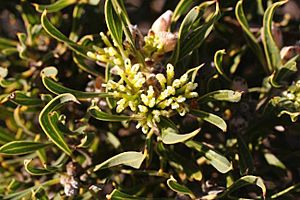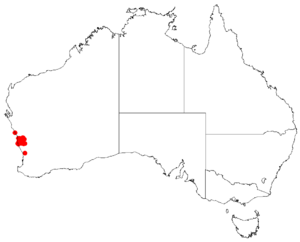Hakea eneabba facts for kids
Quick facts for kids Hakea eneabba |
|
|---|---|
 |
|
| Scientific classification | |
| Genus: |
Hakea
|
| Species: |
eneabba
|
 |
|
| Occurrence data from AVH | |
The Hakea eneabba is a special kind of shrub. It belongs to the Proteaceae plant family. This plant is endemic to a specific area. This means it only grows naturally in one place. That place is along the west coast of Western Australia, in a region called the Mid West.
Contents
What the Hakea Eneabba Looks Like
The Hakea eneabba is a low-growing shrub. It has many branches and can grow from about 1.3 to 5 feet (0.4 to 1.5 meters) tall. Its smaller branches can be smooth or a little bit hairy.
Leaves and Flowers
The leaves of this plant are smooth and stiff. They have a main vein running down the middle. Each leaf ends with a sharp point. The leaves grow either one after another along the stem, or in circles around the stem. They are about 1.2 to 4.7 inches (30-120 mm) long. They are widest above the middle, measuring about 0.16 to 0.55 inches (4-14 mm) wide.
The Hakea eneabba has beautiful chrome-yellow flowers. They grow in groups of 14 to 18 flowers. These flower groups appear where the leaves join the upper branches. Each flower sits on a smooth stalk, called a pedicel, which is about 0.08 to 0.12 inches (2-3 mm) long. The main part of the flower, called the perianth, is pale yellowish to green and measures about 0.94 to 1.06 inches (24-27 mm) long. The style, which is part of the flower's reproductive system, is smooth and about 1.1 to 1.2 inches (28-31 mm) long.
Fruit of the Plant
After the flowers, the plant produces fruit. These fruits are shaped like an egg. They grow where the leaves meet the stem, at an angle. Each fruit is about 0.87 to 0.94 inches (2.2-2.4 cm) long and 0.43 to 0.55 inches (1.1-1.4 cm) wide. They narrow down to a rounded tip, which looks like a beak.
How the Hakea Eneabba Got Its Name
This specific type of Hakea plant is named after the area where it grows. It is found near a place called Eneabba in Western Australia.
Who Described This Plant
The botanist Laurence Haegi was the first to officially describe this species. He did this in 1999. His description was part of a larger work called Flora of Australia. He worked with other botanists like William Robert Barker, Robyn Barker, and Annette Wilson on this project.
Where the Hakea Eneabba Grows
The Hakea eneabba grows in different spots around the Eneabba area. You can find it from Geraldton in the north down to Dandaragan in the south. It prefers to grow in deep sand in areas with heathland plants.
Growing Conditions
This plant is considered an ornamental species. This means it's pretty to look at and can be grown in gardens. If you want to grow it, it needs a spot where the water drains well. It also needs to be in full sunlight.

